You may not find this terribly rewarding unless you're included here, so this is a good time for casual and random browsers to turn back before they get too caught up in the sweep and majesty of the proceedings and can't let go.

We've left the Duomo di Napoli and are coursing along the Via dei Tribunali, passing again the Chiesa dei Girolamini and casting glances all round for interesting stuff . . .

. . . like this Neapolitan version of an antiques store, or . . .

. . . this enormous tribute to the legendary footballer Diego Maradona, formerly a star of the Napoli team -- that was back in the 1980s, but in fact, Napoli was the Serie A national champion in 2022-2023 as well.

And the Basilica di San Paolo Maggiore, nearly destroyed by the Allied bombing of 1943 but wonderfully restored, with a statue of San Gaetano, erected in 1664 in gratitude for having escaped a plague epidemic in 1656; his tomb is inside the basilica. This Piazza San Gaetano was the site of the agora of the Greeks and the forum in Roman times, and the city's administrative centre under the Angevin rulers.
San Gaetano, better known to us as St Cajetan (1480-1547), was a lawyer and diplomat who cofounded the charitable order of Theatines, authorized in 1524, which founded a bank to help the poor (now the Banco di Napoli), hospitals for incurables, and various churches and monasteries; he was beatified in 1629.

Apparently the Piazza San Gaetano is said to be celebrated nowadays mostly for the quality of the pizzerias round the square.

Football enthusiasm and a small boy with a shirt that says 'Street Boxer' in French.

Historically this was the main street of the city, the Decumanus Maximus, and fortunately (like the other two east-west ancient thoroughfares) it's reserved for pedestrians.

We're dropping Kristin off for her reserved place in the next small group to get into the Sansevero Chapel Museum . . .

. . . and we'll all reassemble tonight for dinner . . .

. . . in the Ristorante Transatlantic right here in the borgo. Oscar and Cathy are off for the USA tomorrow morning.
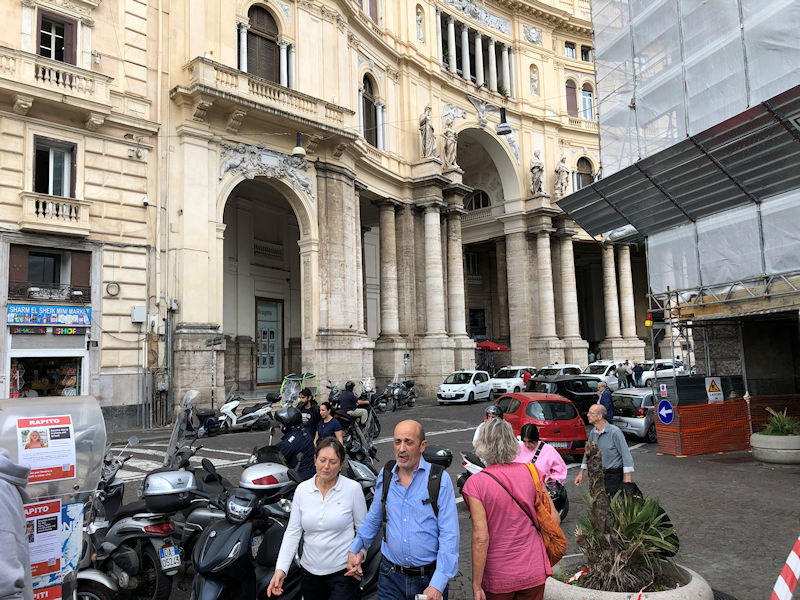
But we have another day here, 31 October 2023, and we're dashing off for even more exhilarating experiences.

Past the Castel Nuovo again and . . .
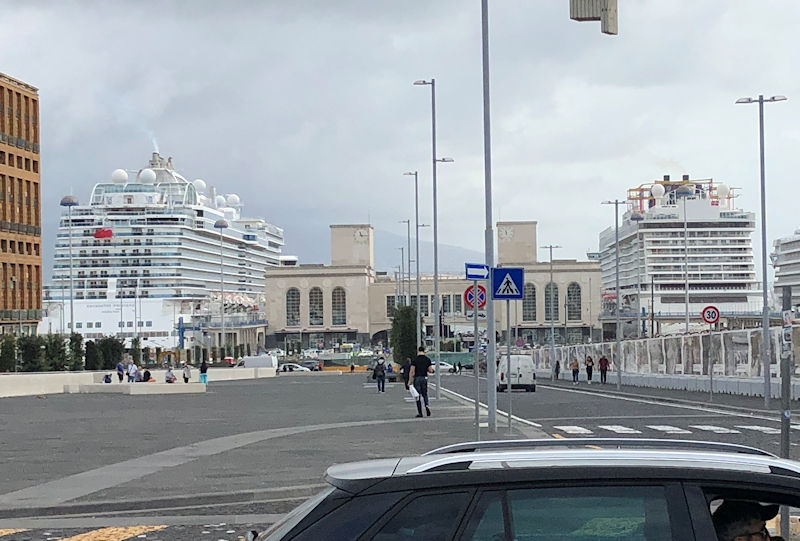
. . . past the Queens of the Seas and their hordes of happy cruiseship adventurers.
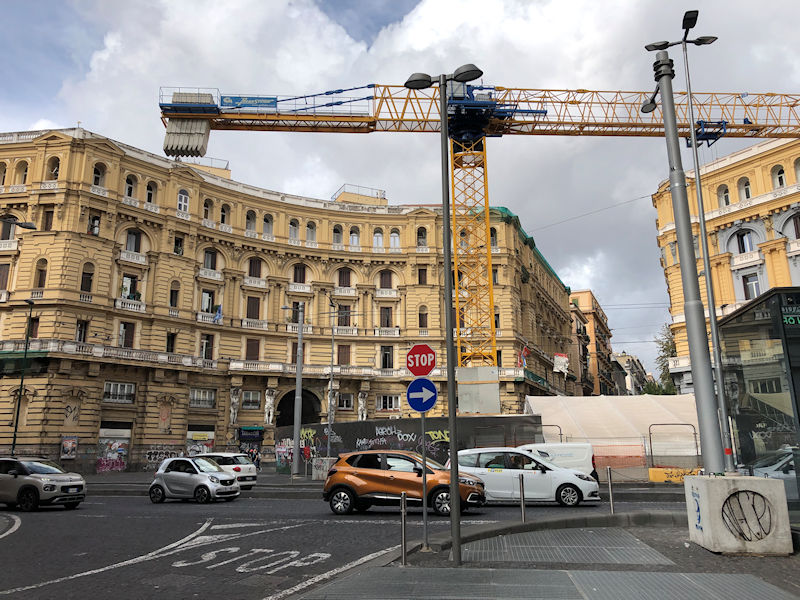
This time we've passed much of the port area along the Corso Umberto I to the Piazza Nicola Amore here, and then straight north up the Via Duomo half a kilometre to . . .

. . . the Via dei Tribunali again. We're here to see the Caravaggio in . . .

. . . the church of the Pio Monte della Misericordia, the 'Pious Mountain of Mercy'.

The Pio Monte della Misericordia was founded in 1601 as a charitable fraternity by seven young noblemen who devoted much of their time to aiding the ill in the Hospital for Incurables. The next year they commissioned a small church near the staircase leading to the back of the Duomo, which was consecrated in 1606. In the mid-late 17th century it was enlarged across the street by combining it with a palace and another church.

There at the end of this alley is the stairway leading up into the Cathedral, and . . .

. . . here is the Obelisco di San Gennaro facing onto the Via dei Tribunali.
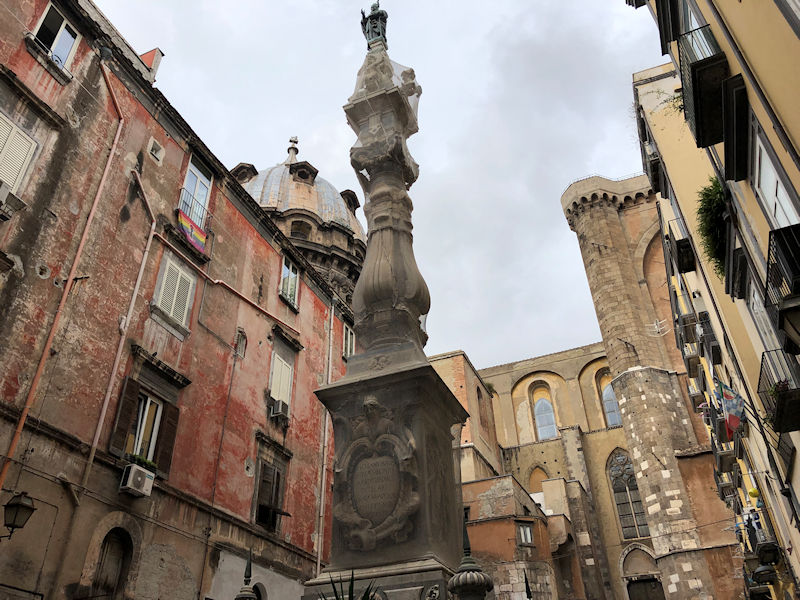
The dome up left belongs to the Royal Chapel of the Treasure of San Gennaro and its museum, and on the right is part of the Cappella Capece Minutolo that we saw the inside of yesterday.

The present church is now a museum, and amongst a good collection of mostly local artists, there is also . . .

. . . this work by Caravaggio, appropriately 'The Seven Works of Mercy', commissioned in about 1607 and originally intended to comprise seven separate works but combined by the artist all into one, which became the church's altarpiece. [The museum has a fascinating interactive of interpretation of the painting here.]
The Catholic Church's tradition of the Seven Works of Mercy consists of: visit the imprisoned, feed the hungry, shelter the homeless, clothe the naked, visit the sick, refresh the thirsty, and bury the dead. Six come from Matthew 25:35-36, the last was added by Pope Innocent III in 1207.

Here is a sort of tactile 'braille' version of the painting. The young men had set out to find painters who could express their sense of their charitable mission, and as fans of the work of Caravaggio they added several works from others that employed the sort of strong chiaroscuro that Caravaggio pioneered.

This, for example, is a picture of St Peter resurrecting Tabitha [Gk. Dorcas] the Widow (from Acts 9:36ff), by the local artist Fabrizio Santafede, dated to 1611.

This is the Deposition of Christ into the Tomb, by Giordano Luca (1634-1705), who began and ended his work in Naples.

This is Christ in the House of Martha and Mary (1612), also by Fabrizio Santafede; according to the accompanying plaque, it 'interprets the work of mercy of giving shelter to travelers with the episode in which Mary and Martha welcome Christ into their home'.

There's more to come, upstairs. Let's try.

We're great fans of Last Supper paintings, because we're persistently curious about what was on the menu. This is the Ultima Cena by Francesco de Mura (1696-1782), who worked mainly in Naples and Torino and doesn't seem to have had any idea himself of . . .

. . . what was on the menu. Only that it was grey and seems to have had at least one foreleg.

We also tend to seek out pictures with a funny-looking Baby Jesus, and . . .

. . . this chubby, jowly little fellow qualifies. This is an Adoration of the Magi from about 1520, attributed to Giralamo Ramarino, called Girolamo de Salerno.

Also by Fabrizio Santafede, this is the Holy Family with St Lucia, early 17th century (we also collect pictures with St Lucia and her eyes on a plate).

[Don't lean over the pigeon railing.]

This is a portrait of Marcantonio II Colonna (1535-1584), Duke of a bunch of places, who served as a military commander mostly for the Spanish forces (beginning at the age of 18), as captain-general of the fleet in the famous victory against the Moors at Lepanto in 1571 (where he rescued the overall commander Don John of Austria), then as Captain General of the Papal Forces and, in 1577, as King Philip II's Viceroy of Sicily. The portrait is attributed to the workshop of Scipione Pulzone (1544-1598, called 'Il Gaetano') of Naples, painted 1570-1580.
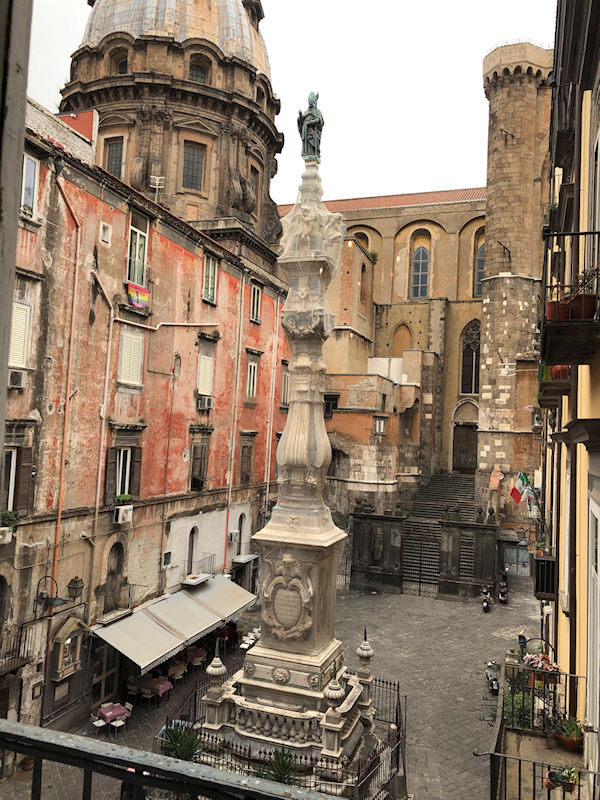
Here's an upstairs view of the vicolo at the side of the Duomo, with the dome of the treasury chapel and the obelisk of San Gennaro.

There was a lot more here to be seen and we saw much of it, but it's time now to move along.
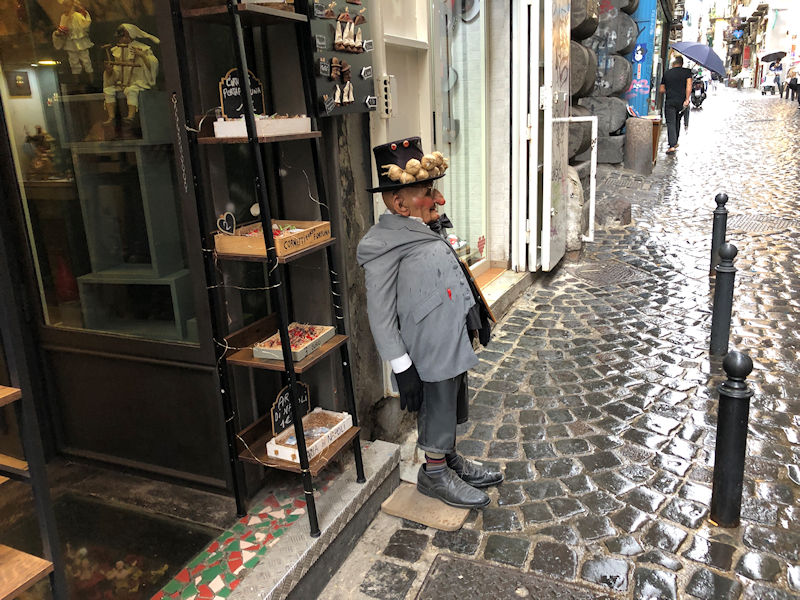
-- You can bring my car around now, there's a good chap.

The wedding feast appears to be a panino or a folded pizza.

We're heading along the Via dei Tribunali to visit, just across from . . .

. . . the Piazza San Gaetano, the . . .
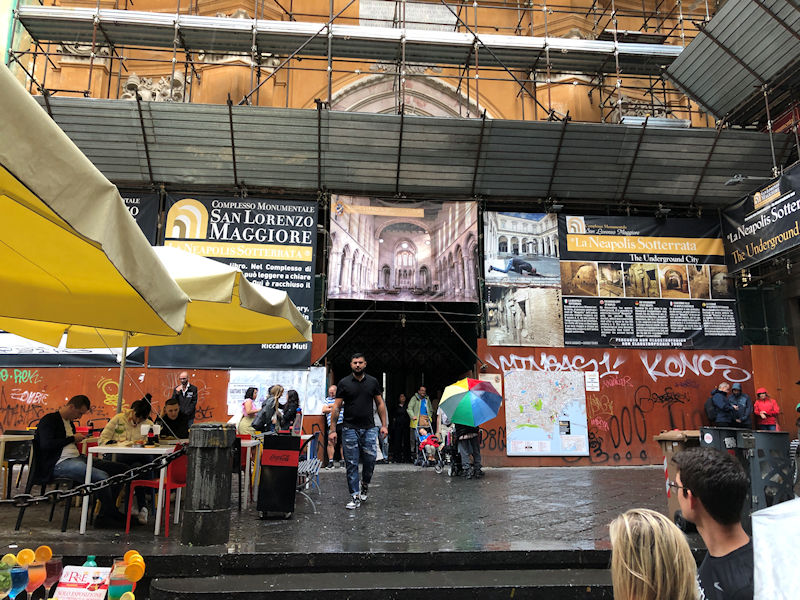
. . . Complesso Monumentale San Lorenzo Maggiore.

The new ruler of Naples and the south, Charles I of Anjou, commissioned this church in 1270 for the Franciscan Order, apparently in compensation for having taken over their church for the construction of his new fortress. It's on the site of a 6th century Christian church which was itself built on the forum and marketplaces of the ancient city (much of which has been and is being excavated and open to the public since 1992).

The main altar. King Charles, being French, brought along his own architects and craftsmen in his entourage, and beginning with the east end, they employed the traditions of the northern French Gothic style. As the work progressed into the next century, the Italian workers began to shift over to what it is now called the Gotico Angioiano, i.e. French-style Gothic mixed with Italian traditions. Thus, this church 'consists of choir and ambulatory with ribbed vaults in "Parisian" Gothic style, and transept and nave with pointed arches but open sight into the woodwork of the roof, as it is frequent in Italian architecture' (Wikipedia sub 'Gotico Angioiano').
The main altar, by Giovanni da Nola in 1530, features statues of St Lorenzo (Lawrence), St Francis, and St Anthony.

This is the ornate Cappellone of Saint Anthony in the back wall of the left transept, a baroque work by Cosimo Fanzago in 1638.

The sepulchre of Robert IV of Artois, Count of Eu, and Joanna (Giovanna) Duchess of Durazzo, who married in about 1376 and were at the Castel dell'Ovo when they were poisoned in July 1387 on orders of Joanna's younger sister Margaret, who was then the queen dowager and regent of Naples as guardian for her minor son Ladislaus. The sepulchre dates from 1399.

The glass windows under the floor of the transept allow views of the very early mosaic flooring below, amongst the recent excavations.

They were part of the sacristy of the early Christian basilica of the 6th century, where sacred vestments etc. were stored.

That's the tomb of Mary of Durazzo, daughter of Charles of Durazzo, King of Naples from 1382 (when he had Queen Joanna I assassinated) to 1385. The little girl was only 2 or 3 when she died in 1371, and here on the front she's accompanied by two angels.

The funeral monument of Catherine of Austria, daughter of Albert I Habsburg, who was King of Germany from 1298 to 1308. She was married to Charles, Duke of Calabria, at age 21 in 1316, but died in Naples without issue in 1323. This was made by Tino da Camaino in 1324. That said . . .

. . . there's no use letting cute little lions go to waste.

This is the tomb of the Cecinello family, with Carlo Tucci Cicinielli and his son of the same name snoozing atop it.

A fine relief of the Madonna, Child and Angels, once part of the main altar, made by Giovanni da Nola in about 1530.
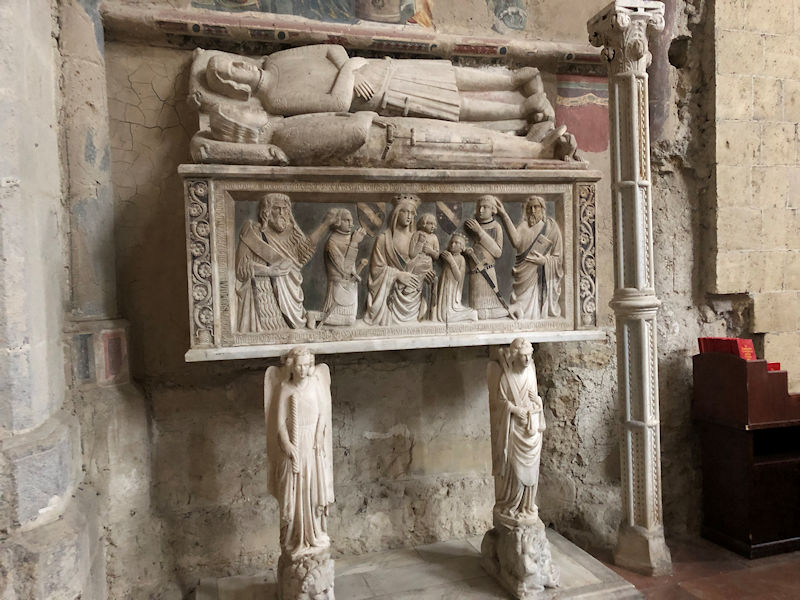
The funeral monument of Ludovico Caracciolo, made in 1335, with cute little telamons of Justice and Charity.

In front of the passage to the convent and cloister, this is the 16th century pulpit, with a picture of St Catherine of Alexandria in front of the tyrant Maxentius.

The side chapel with the notation 'Preghiera dell'Ecce Homo'

There's much more to be seen here -- there's more good stuff in the church, of course, but there are also the monastery (both belonging to the Conventual branch of the Franciscans), the cloister, a new museum covering the ancient and more recent history of the area, and the excavated Roman market below.
We should mention that it was probably in the Basilica di San Lorenzo that in 1336 Giovanni Boccaccio first met the ‘inspiring muse’ that he called Fiammetta in many of his works – rather like Dante’s Beatrice and Petrarch’s Laura.

Greeted by a downpour in the Piazza San Gaetano

Last glimpses of the wonderful Via dei Tribunali

Pizzeria del Purgatorio doesn't sound promising, one would have thought.

There's the source of the 'Purgatorio' part, but it's still all a bit confusing.

Commissioned in 1616 by the lay congregation Opera Pia Purgatorio ad Arco and consecrated in 1638, the building has an upper 'church that recalls the earthly dimension and a Hypogeum, a cemetery area, which concretely represented Purgatory. The care of the souls of Purgatory was one of the main points of the new counter-reformed church.'
It 'still today hosts the intense and spontaneous cult of the souls of Purgatory'! (source)

Good grief -- there they all are, in Purgatory, flames and whatnot, somebody needs to help them! That's the point of this, of course.

We'll leave a bit abruptly.

A familiar sight by now, where we turn down towards the port area.

Down the 'Via Raimondo de Sangro di Sansevero' (really)
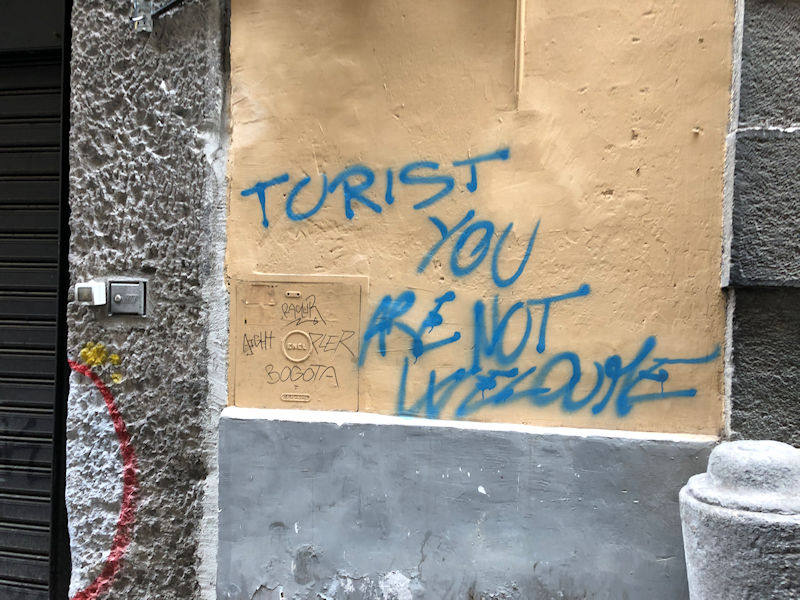
-- All right, all right, we get the message.

Goodbye to the Castel dell'Ovo, and dinner at Donna Lucinella next to our flat: very good.

All packed up, and . . .
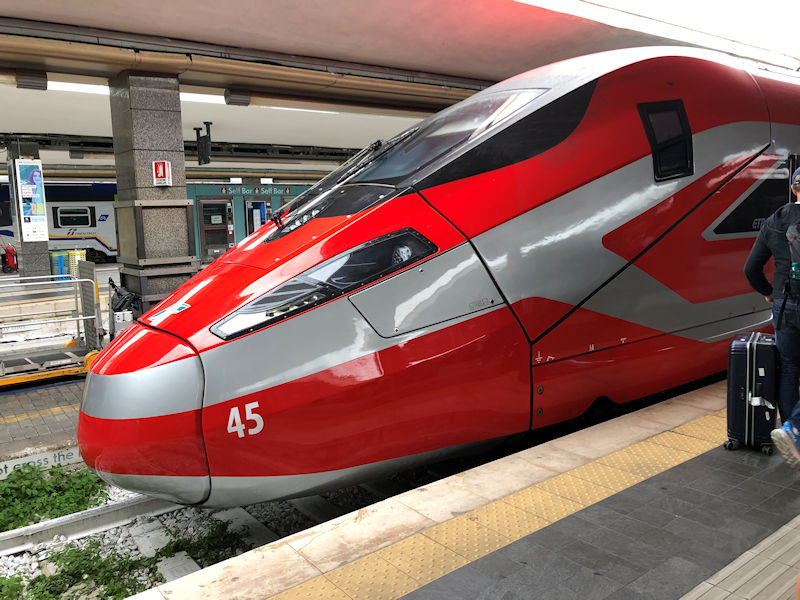
. . . boarding the Frecciarossa for Rome and Fiumicino for our flight home tomorrow. Well, not really -- United canceled our flight, without informing us, and we had to rebook to Frankfurt the following day, thence to Chicago some hours later. Thanks again, United; keep up the good work.
Next up: Some November forest walks in Staunton, Virginia


 Dwight Peck's personal website
Dwight Peck's personal website




















































































